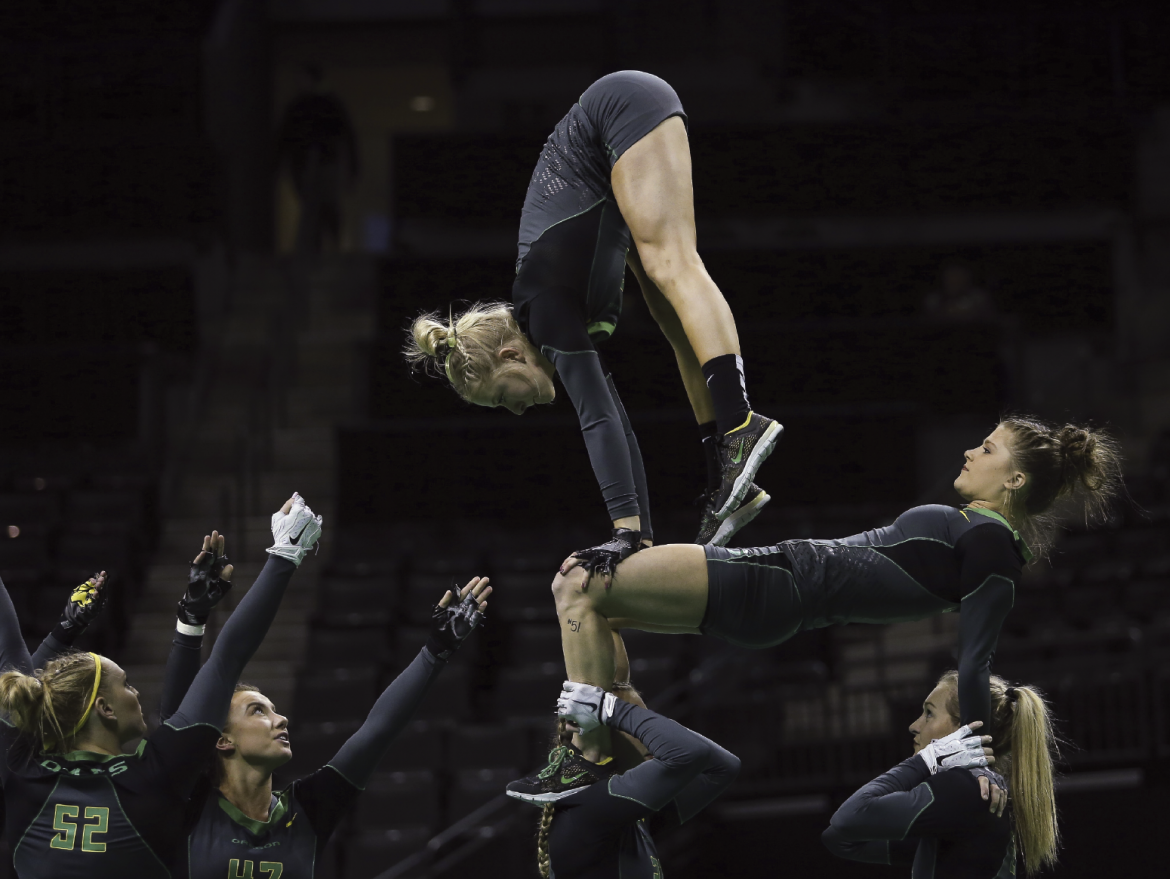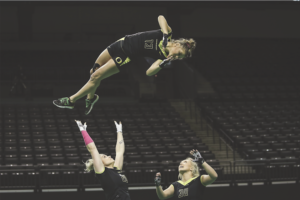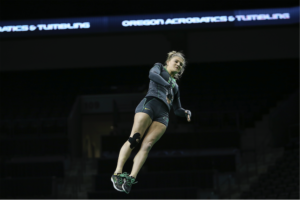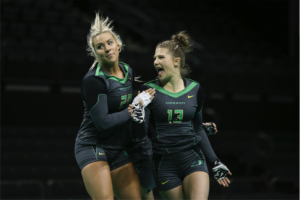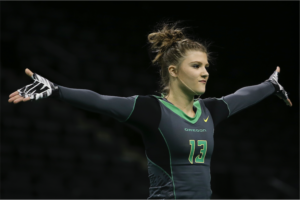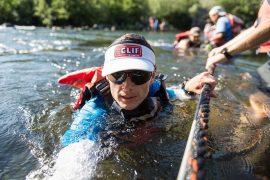University of Oregon’s Acrobatics and Tumbling Team is Flying High
written by Sheila G. Miller | photos courtesy of UO Athletics
Take cheerleading and add gymnastics. Now, get rid of the smiles and the skirts and the hair bows. That’s acrobatics and tumbling, and that’s the sport University of Oregon senior Alexis Cross is proud to be a part of.
Considered an “emerging sport” by the NCAA but currently governed by an outside association and in talks to become an official NCAA-sanctioned sport, acro/tumbling is no joke.
“We get rid of all the glitz and the glam of cheerleading and the leotards and hair bows of gymnastics,” she said. What’s left is the stunting part of cheer and the tumbling portion of gymnastics.
The sport was created fairly recently, and only a handful of universities have teams. Oregon has been to the national championship four years straight—winning in 2014 and getting runner-up in 2015, 2016 and 2017.
“Everything we do has point values, and our scores are based 100 percent on execution,” Cross said. “It’s not subjective. In cheerleading you can get subjective scores based on how someone liked the routine, how popular the team is, whether the team has a couple superstars, the flair that goes with it. This is very much execution-based.”
Cross said the sport was designed by women to give female athletes more opportunities to compete—and that’s what she likes about it. Cross’s background is in competitive cheer, though she also played soccer in high school. In fact, “I drove to Portland—two hours, three days a week—to practice competitive cheerleading,” she said. “I would say those practices were two to three times harder than soccer was.”
When she arrived at the University of Oregon, she was moved by the respect the acro/tumbling team receives. “We are treated like every other athlete here,” she said. “Growing up as a kid I would say, ‘I do cheerleading,’ and people would tell me, ‘That’s not a sport.’ I definitely understand people’s arguments, but it was disheartening.”
There are no men in this sport. It’s women only, tossing other women through the air, flipping through tumbling passes and building elaborate pyramids.
The team practices three hours a day, plus weight-lifting and running daily. Practices in the preseason involve a lot of basics, as well as learning new skills—and that means a lot of falling.
“It’s definitely scary to try at first,” Cross said. “You’re up 10 to 15 feet in the air, free falling. … It’s very much a mental thing going into those tosses. You have to be willing to go for it, and go for it 100 percent because going halfway just doesn’t work very well.
“You also have to be willing to fall. That was something I didn’t expect, to fall as much as I do. It’s kind of a cool position to be in now though—my fear has diminished and it’s just like, ‘Here we go.’”
Each head-to-head competition features six events, with several heats in each event—compulsory, in which each team demonstrates the same skills; acrobatics; pyramid; tosses; tumbling, and a team routine.
The team routine is the hardest: “That’s full-out two minutes and thirty seconds of everything all put together to music,” she said. “It’s so fast-paced. It’s like the equivalent of Olympic lifting and then running.”
With forty-three team members, different athletes participate in different parts of the meet.
One of the biggest challenges for Cross is staying healthy. The impact on a tumbler’s joints is significant. “I highly value the athletic medicine staff,” she said. “We have a graduate assistant trainer just with our team and we always say they save lives. I’m in there probably two hours before practice every day to roll out, get treatment for anything that’s hurting, do rehab. You just have to be committed to physically caring for your body even if it doesn’t hurt, taking precautions and preventive measures.”
Plus, Cross gets really hungry during the season. She focuses on getting protein in every meal and staying away from processed foods. More than anything, though “the main thing I notice is the quantity of food I eat. I find myself being hungry a lot.”
And Cross is hungry for more—this year, she said, she’s hopeful her team will have a better showing at the national championship. “We can finally bring it back home.”
[su_panel]
University of Oregon Acrobatics Workout
An average training day includes a one hour weights session, a fifteen to thirty minutes of cardio exercise, and a three-hour practice consisting of tumbling conditioning and acro repetition.
University of Oregon Acrobatics Inspiration
Trust is a big part of our sport. We literally put our lives in one another’s hands every single day, so it becomes second nature. It’s easy to continue working hard because I trust that my teammates are doing the same, and not working hard would be letting them down.
University of Oregon Acrobatics Nutrition
My favorite foods include avocado, cereal and Cafe Yumm. During season, I don’t necessarily eat anything special, but tend to be hungry all the time so the quantity increases.
[/su_panel]


